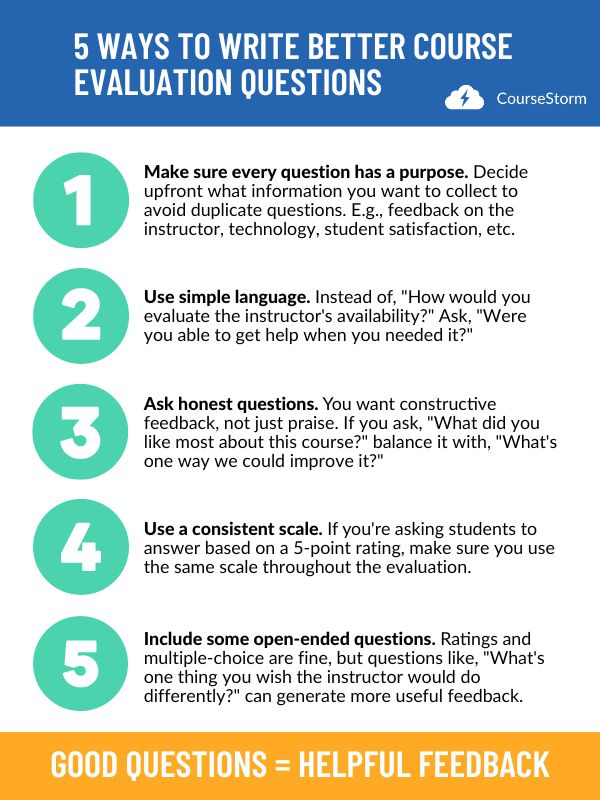Best Practices
How To's
The Best Course Evaluation Questions and How to Write Them

Course evaluations can help make your classes better. They collect meaningful data about students’ experiences, what they learned, and how they felt about the class. You can use that information to improve your courses and make them even more attractive to future students. But getting useful and honest feedback from students takes some finesse.
Good course evaluation questions invite students to share their real opinions. They offer insight into the student’s experience so you can make changes based on data, not guesswork. Each question must be carefully written and designed with a specific aim in mind. Here is some actionable advice you can use on your next class feedback survey.
How to Write Better Course Evaluation Questions
If your program has been around for a while, you may have been using the same student evaluation form for years. New programs may just grab the first course evaluation form template they see online and assume it’s good enough. Neither of these are great strategies.
If you want quality feedback, you need quality questions. That means you need to write specific questions targeted to your students and your classes. Here are five ways to write better course evaluation questions. Each step is explained in more detail below the graphic.

1. Make Sure Every Question Has a Purpose
Every question on your course evaluation survey should have a purpose. Before writing any questions, make a list of the information you want to collect. This list helps you gather all of the information you need without repetition.
You might want to get feedback about:
- the instructor and teaching methods
- course content
- quality of assignments and assessments
- the overall learning experience
- whether the course met student expectations
- tools or technologies
2. Keep Your Language Simple
Use simple, straightforward language and avoid jargon wherever possible. Instead of, “How would you rate the instructor’s use of differentiated instruction?” Ask, “Did your instructor do a good job of adjusting the material to meet your learning needs?”
3. Ask Honest Questions
You want students to provide their constructive feedback, not just their praise. So avoid filling your survey with questions that demand positive responses. If you do ask a question like, “What did you like most about this course?” balance it with a question like, “What’s one thing we could do to improve this course?”
4. Use a Consistent Scale
If you’re using a rating scale, make sure you use the same scale throughout the survey. Don’t offer a five-point scale on the first question and a seven-point scale on the third question. Make sure the meanings of each number stays consistent. If 1 equals “strongly disagree,” that meaning should be the same throughout the survey.
5. Include Some Open-Ended Questions
It may be easiest to manage evaluation results that are all based on multiple-choice questions. They give data you can easily use and compare on an evaluation report. However, these types of questions are limiting because they don’t encourage students to share their unique perspective. To get more useful feedback, include open-ended questions like: “What is one thing you wish the instructor would do differently?”
Remember to ask the most valuable question: “Is there anything this evaluation didn’t cover that you would like to share?” This question can sometimes reveal problems or praise you would have missed otherwise.
Test and Refine Your Class Evaluation
Test out your evaluation with a small group of students. Pay attention to whether students skip questions and whether the answer fits the question. Either of these can reveal that a question needs to be refined.
Sample Course Evaluation Questions
We’ve suggested some examples below to help get you started with writing course feedback questions. The questions are organized based on the part of the course they assess. To make it even easier, use our course evaluation template in Google Forms. Simply make a copy of the form and edit the questions to meet your needs.
Use our customizable course evaluation template to get started gathering feedback that can improve your classes.
Course Content/Structure
- The course was well-organized and logically structured. (scale of 1-5)
- The course covered everything promised in the course description. (scale)
- This course helped me improve my skills/understanding in [subject]. (scale)
Instructor Evaluation
- I could tell my instructor is an expert in the subject matter of this course. (scale)
- The instructor clearly communicated expectations, deadlines, and grading criteria. (scale)
- The instructor provided timely feedback on assignments and assessments. (scale)
Teaching Methods
- The instructor used a variety of teaching methods (lectures, discussions, group projects, etc.) to engage students. (scale)
- What method of teaching most helped you understand the material? (multiple choice)
- Were the teaching methods effective in helping you understand and apply the course material? (long-form answer)
Assessments/Assignments
- The assignments improved my understanding of the material. (scale)
- The assignments and assessments fit with the material we covered in class. (scale)
- What assignment did you feel was least helpful and what would improve it? (long-form answer)
Resources
- The learning resources (textbooks, online content, websites) were accessible and relevant. (scale)
- What additional resources would have been helpful for you? (long-form answer)
- The course website [or learning management system] was up-to-date and helpful. (scale)
Class Experience
- Class sessions were useful and interesting. (scale)
- I was able to get help when I needed it. (scale)
- How could we improve the class experience for future students? (long-form answer)
Overall Experience
- I would recommend this course to other students. (scale)
- What aspects of the course were most beneficial to your learning experience? (long-form answer)
- How could we improve this course overall? (long-form answer)
How to Get Students to Complete Course Evaluations
After you’ve worked so hard to write great course evaluation questions, it can be frustrating if students don’t fill them out. Here are a few reasons your student response rates might be low and what to do about each one.
Here are 3 common problems instructors encounter when trying to get students to fill out course evaluations, plus solutions for each one.
Problem: The evaluation takes too long to complete.
Solution: Make sure your evaluation is short and focused. Then, give students in-class time to answer the questions. If you’re using an online course evaluation, give students an estimate for how long the survey will take.
Problem: Students are worried about upsetting or offending the instructor.
Solution: Assure students that their feedback is anonymous and confidential. If you’re teaching an in-person class, leave the room while students complete the evaluation.
Problem: Students do not believe that their feedback matters.
Solution: Explain that their feedback will be used to improve teaching and learning for future classes. If possible, give an example of how student feedback has been used in the past. Thank students for their insight and participation.
How to Deliver Course Evaluations to Students
Many learning management systems (LMS) have course evaluation tools built in. Moodle, Blackboard, and Canvas all have student feedback forms you can customize. If you’re not using an LMS but still need a digital solution, you can use an online survey tool. We like Google Forms but SurveyMonkey, SurveyPlanet, and Zoho also offer some free options.
Collecting student feedback helps you improve your classes and make sure instructors are teaching effectively. You might discover new ways to enhance the student experience or improve your offerings. But keep in mind that the student experience doesn’t start at the first class session, it starts at registration.
CourseStorm’s online class registration and payment processing simplifies this step and provides a seamless experience for students from the start. Contact us to learn more or start your free trial today.

Greg Shula
Greg has spent a decade analyzing business and marketing performance metrics of the companies he has worked with. He uses his analytical mind and investigative skills to find trends and simple answers from complicated data sets. Greg is also an amateur photographer who loves to capture nature from new perspectives.
